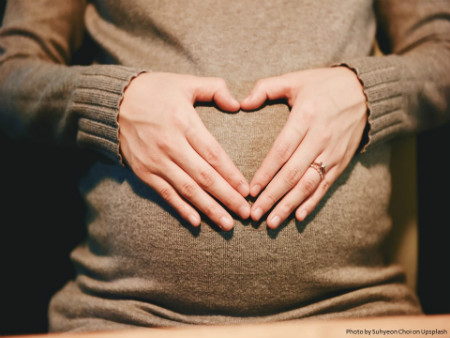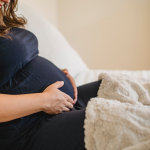Understanding post traumatic stress disorder (PTSD) during pregnancy is important given that PTSD is relatively common and persistent in nature. PTSD will occur in approximately 10% of women in their lifetime, with one-third of episodes lasting more than five years. Given the relatively high prevalence of PTSD in young women and the chronic nature of the illness, many women may experience PTSD symptoms during pregnancy.
PTSD is diagnosed when an individual has persistent symptoms related to a traumatic event, including re-experiencing the event (for example in the form of flashbacks or nightmares), avoiding feelings, people or places associated with the traumatic event, and having hyperarousal, or a high general level of anxiety, that can result in symptoms such as insomnia, startling easily, or irritability and outbursts of anger.
Studies have suggested that rates of PTSD are higher in pregnant women than in non-pregnant women. Some researchers have hypothesized that the unique psychological and physical aspects of pregnancy may exacerbate symptoms of PTSD. For women who have PTSD related to childhood abuse, for example, the process of preparing to become a parent can carry complex feelings and may worsen anxiety. Additionally, physical changes during pregnancy or routine prenatal care could trigger symptoms in women with a history of sexual abuse. In addition, women may stop psychotropic medications used to treat PTSD during pregnancy, thus increasing the likelihood of an increase in symptomatology.
Alternatively, sampling error in these studies may be responsible for higher reported rates of PTSD. Some symptoms of a normal pregnancy, such as insomnia, overlap with the symptoms of PTSD and could lead to a falsely elevated report of PTSD symptoms. Additionally, the majority of studies examining PTSD rates during pregnancy have studied young women from low-income community samples, a subpopulation with higher rates of PTSD at baseline.
A recent study by Seng and colleagues investigated perinatal outcomes for women with and without PTSD. In the study, 839 women were interviewed during their first pregnancy regarding a history of trauma and associated PTSD symptoms. The women fell in to three groups: women with PTSD, trauma-exposed women without PTSD and women without trauma histories. Perinatal outcomes including birth weight and gestational age were gathered from medical records at the time of delivery.
In this study, infants born to mothers with PTSD had a lower mean birth weight than infants in either the trauma-exposed group without PTSD or the group without a trauma history. This study did not address possible mechanisms for poorer perinatal outcomes in this population. It is not clear whether it is PTSD alone that leads to negative perinatal outcomes. One confounding factor is that PTSD is highly comorbid with depression and other anxiety disorders, which have also been associated with lower birth weight in infants and other adverse outcomes. Additionally, at least one study (Smith 2006) found that women with active PTSD symptoms in pregnancy were more likely to engage in poor health behaviors, including substance use, which may have a more direct impact on infant outcomes.
For women with PTSD, treatment is available. First line treatments include psychotherapy and antidepressant medication (selective serotonin reuptake inhibitors or SSRIs). Therapy targeted at PTSD symptoms during pregnancy should focus on establishing a sense of safety and coping with active symptoms. Exploration of traumatic events should only be done when a woman is not in crisis. Given the potential for worsening of symptoms, engaging in exploratory therapy would not be recommended during pregnancy or the postpartum period. Women should discuss the risks and benefits of treatment with their doctors, and medication should be used when potential benefits outweigh the risks.
Julia Wood, MD
References:
Seng JS, Low LK, Sperlich M, Ronis DL, Liberzon I. Post-traumatic stress disorder, child abuse history, birthweight and gestational age: a prospective cohort study. BJOG. 2011 Oct;118(11):1329-39.
Seng JS, Rauch SAM, Resnick H, Reed CD, King A, Low LK, McPherson, M, Muzik M, Abelson J, Liberzon I. Exploring posttraumatic stress disorder symptom profile among pregnant women. J Psychosom Obstet gynaecol. 2010 Sept; 31(3):176-187.
Smith MV, Poschman K, Cavaleri MA, Howell HB, Yonkers KA. Symptoms of Posttraumatic Stress Disorder in a Community Sample of Low-Income Pregnant Women. Am J Psychiatry 2006; 163:881-884.







Consider the possibility for studying the effects for prophylaxis of PTSD or depression. The study group could be women who have lost a viable pregnancy. In this situation, such as abruption , cord accident or undetected growth restriction, a day can go from seemingly normal to catastrophe.
The problem is that most people get no help after this horrible turn of events. Generally speaking, if the patient desires, clonazepam 1 -2 mg qhs for 3 weeks and .5-1 mg qd for 1 week. Additionally sertraline at 25 mg qhs. Clinically I have seen better outcomes for this group in terms of length and depth of depression.
One must consider that in these situations, the risk of post partum depression is 100% and the replay of the news that the baby is not alive will be etched into the brain for years. Pretreatment is not to avoid mourning, it is to help a mourning process to occur then a return to baseline. One could debate aggressive anxiety and depression treatment, thus a study in this group may help with ideas on immediate post trauma protocols.
Nice article, well written and informative. Thank you. Chevies Newman,MD
@Chevies Newman, I think you bring up several very good points. The first is that we probably do not give enough attention to losses that occur during pregnancy. I don’t think every woman who experiences a loss will go onto have depression, but clearly this is a traumatic experience.
A significant proportion of women who experience a loss or some other catastrophic event during pregnancy later develop PTSD.
You have hypothesized that we might be able to prevent PTSD in these women. You mentioned early treatment with anxiolytics or SSRIs. To the best of my knowledge, this has not been studied in this population but these sorts of interventions are being tested in other populations experiencing trauma.
While a loss or a complication during pregnancy can be a devastating experience; however, most women recover and many will become pregnant again. It is likely that these women are more vulnerable to PTSD during a subsequent pregnancy, and it would be important to know if there are any interventions which may reduce this risk.
Thanks for your comments.
Thank you,
There is likely a correlation with gestational age, in that an 8 week miscarriage is not the same as a 32 week fetal loss. You are correct in that they all do not develop depression. There is no data there, however, and clinically I have never seen anyone experience a late 2nd or third trimester loss who did not.
It can certainly result in hypervigilance, during the next pregnancy. I have seen, what appears, a better outcome using a combination of a very low dose ssri (25 sertraline) with anxiolytics ( clonazepam 1 -2 mg qhs and .5-1 mg during g the day) as a prophylaxis which may give downside protection.
Diseases of organ systems, for the most part, do better with preventative care. Statins, oral hypoglycemics, preventative antibiotics, vaccination and blood pressure medications are given to prevent or diminish a state of disease.
It seems that preventitive measures for the brain after acute psychiatric trauma should decrease the risk of a paralysing depression. One must good basic psychopharmacology skills. These skills among OB/GYN physicians are generally not well developed. Giving the wrong medications could exacerbate anxiety.
In my opinion, the risk is high for a fetal loss, and the risk of medication is low. The sin of commission is a better error than the sin of omission. It must be done with the right medications, oriented toward anxiety and very low dose ssri, but I have seen these do more good than harm.
Thank you again, this site is an excellent resource. We are fortunate to have this resource. Once again, good article.
Hi – Love these readings on pregnancy, motherhood & mental health. Just some thoughts from my clinical life…As a therapist who specializes in the perinatal period, I think there are several “categories” of PTS/PTSD in pregnancy and of course these overlap. I see many women who suffer from situational, normal grief/depression from pregnancy loss, along with situational PTS from the(necessary) medically induced/supported labor of the stillborn. There are also women with situational PTSD from traumatic births, births where there were many normal & necessary yet intrusive medical procedures. These situations are exacerbated if the mom has a pre-existing mental illness. Then, there are the women who are suffering with chronic, lifelong PTSD from abusive pasts or unmanageable present-life situations. What I hear most often from women about the medical trauma suffered, If only SOMEONE had spoken to me, if only SOMEONE had acknowledged me as a person, I would have coped much better. I see that as a request for improved maternity care on the medical side. AND I also hear much actual despair from the mom, her mom-baby attachment process after a traumatic birth may never be complete b/c she did not have skin-to-skin with her baby right after birth. So, then we need to address the feelings, the re-framing & understanding of both the medical establishment and how it runs and also educated on the true nature of the infant attachment process (a long process with room for resiliency and correction,not only dependent on the first few moments of life.) I am a great advocate of infant/mom bonding, etc…but there is room for improvement on the natural childbirth discourse as well, a responsibility to present attachment research. With respect, Kathy
Hi Kathy,
When it comes to mental health, there seems infinate variations in where it goes wrong. There is contravorsy in the medical treatment of grief. Personally, I view the medications, when properly applied, to be neuroprotective. The grief will come, perhaps it can be made less deep and wholeness restored faster if the brain is treated. The basic treatment of only insomnia for a short period may prevent the sleep-wake dystegulation so prominant in almost every form of psychiatric pain.
I believe that good psychiatry will be implemented into obstetrics and gynecology. In my analysis I determine the extent of the anxiety vs extent of depression. I usually find anxiety predominate nightime hyperarousal, daytime lack of arousal and secondary depression.
During severe acute stress in pregnancy, loss or dealing with impending loss, “putting the brakes on” with good medication has been greatly appreciated. It may make your job easier as well.
There is no substitute for the good psychotherapist. Our problem is that it can be difficult to get the therapy in the Medicaid population. I wish you lived around my area in Louisiana, there would be plenty of work. Thank you for the great comments.
@Chevies Newman, Thank you for your kind reply. (I have noticed that only MD’s get replies on this blog, so I have stopped reading it, but I received notification of your msg in my inbox.)
I think your point is salient that so few ppl receive help after a traumatic turn of events at a birth..and I have much respect for obs, they have alot of pressure nowadays…And of course the medicaid population is difficult to reach….
What I try to do is reach out to the obs in my area, but it seems hard to connect, as many patients dont have mental health care in their plans, and also many don’t understand (or are unsophisticated about) the far-reaching effects of depression or trauma, thus undervalue their mental health.
m/b someday we’ll meet at a conference…take care, Kathy
hi im 40 years old and suffer from ptsd..tell me I want to have a baby but don’t no if its the decision or not! or will the baby end up abnormal! please need some serious advice from anyone!
Hi I’m 28 years old and 6 months pregnant, my dad past away when I was 14 and haven’t had the best relationships with guys there after. My boyfriend that I’m with now, we have had drastic ups and downs with our relationship where he has threatened to leave numerous times and packs his bags about once a week still till this day. I believe I have PTSD due to the death of my dad and issues in the past with my relationship. Whenever I try to leave the house and get in my car I can’t breathe, throw up, feel like I’m choking, start shaking and get very overheated and lightheaded. So due to that I don’t drive or leave the house and when I do that always happens. What can I do?? I’ve talked to my Dr and he just thinks it’s pregnancy but that’s not it at all. Can you please help me? Don’t want any harm to come to my baby.
It may be helpful to meet with a psychiatrist. Although the loss of your father was undoubtedly a traumatic event, you may not necessarily have PTSD. You might want to do some reading about panic attacks.
This article has some good information about panic attacks and their treatment.
Thank you so much for that article. That does sound more of what I’m going through. I really appreciate your help. God bless you.
PTSD is definitely something to take seriously. Combine that with pregnancy and you’ve got a serious melting pot of emotional hormones flooding around. As a therapist, I highly encourage you to seek some professional help from a mental health counselor. The pregnancy is on a firm timeline and cannot change lol, but maybe with a solid therapist, something could be improved on the PTSD during this time. It doesn’t hurt as most therapists do free first sessions to give people a feeling for how it goes. You have nothing to lost giving it a try.